Shaking Table Substructure Testing Based on Three-Variable Control Method with Velocity Positive Feedback
Abstract
1. Introduction
1.1. Background and Motivation
1.2. Scope
2. Explicit CDM for STST
2.1. CDM for Dynamic RTHS
2.2. Explicit CDM for STST
3. Methodology of STST Based on TVCM-VPF
3.1. Conventional TVCM for SST
3.2. TVCM-VPF for STST
3.3. Implementation Procedures
- (1)
- Initialize the experimental parameters, e.g., , , , , .
- (2)
- Calculate the displacement using Equation (4) at the initial sampling instant of the (i + 1)th integration time step with the measured reaction force and the known .
- (3)
- Update the velocity and acceleration at the ith step using Equations (2) and (3).
- (4)
- Determine the target acceleration of the specimen using Equation (6).
- (5)
- Calculate the target displacement and target velocity using Equations (5) and (9) at each sampling time t with the calculated .
- (6)
- Generate the actuator command at each sampling time t with the TVCM, i.e., the feedforward block and the feedback block, loading the shaking table.
- (7)
- Go back to Step (5) until the end of each integration time interval.
- (8)
- Measure the corresponding reaction force and return to Step (2) until the end of the test.
4. Experimental Validation of STST Based on TVCM-VPF
4.1. Prototype Structure
4.2. Method and System of STST Based on TVC-VPF
4.2.1. Strategy of STST
4.2.2. Characteristics of the NS
4.2.3. ES and Shear Force Measurement
4.3. Results of STST Based on TVCM-VPF
4.4. Comparison between STST and Conventional STT
5. Conclusions
Author Contributions
Funding
Conflicts of Interest
Nomenclature
| Symbols | |
| Mass matrices of the NS | |
| Damping matrices of the NS | |
| Stiffness matrices of the NS | |
| i | Integration time step |
| Reaction force vector of the ES | |
| External excitation force vector | |
| Acceleration response vectors of the NS | |
| Velocity response vectors of the NS | |
| Displacement response vectors of the NS | |
| Integration time interval | |
| Displacement targets for the specimen | |
| Velocity targets for the specimen | |
| Acceleration targets for the specimen | |
| I | Interface DOF of the two substructures |
| t | Time |
| Displacement feedforward gains | |
| Velocity feedforward gains | |
| Acceleration feedforward gains | |
| Open-loop gain of the hydraulic system | |
| s | Laplace operator |
| Natural damping ratio of the hydraulic system | |
| Resonant frequency of the hydraulic system | |
| U | Displacement command input |
| x | Displacement response output |
| Displacement feedback gains | |
| Velocity feedback gains | |
| Acceleration feedback gains | |
| Desired equivalent open-loop gain of the system under TVC. | |
| Desired frequency of the system under TVC. | |
| Desired damping ratio of the system under TVC. | |
| Shear force | |
| Total shear force obtained from the measurement table | |
| Mass of the upper steel plate | |
| Acceleration measured by the accelerometers installed on the upper plate. | |
| Abbreviations | |
| STST | Shaking table substructure testing |
| TVCM | Three-variable control method |
| VPF | Velocity positive feedback |
| RTHS | Real-time hybrid simulation |
| ES | Experimental substructure |
| NS | Numerical substructure |
| TLD | Tuned liquid damper |
| STTs | Shaking table tests |
| RTST | Real-time substructure testing |
| DOF | Degree of freedom |
| PID | Proportional integral derivative |
References
- Nakashima, M.; Kato, H.; Takaoka, E. Development of real-time pseudo dynamic testing. Earthq. Eng. Struct. Dyn. 1992, 21, 79–92. [Google Scholar] [CrossRef]
- Horiuchi, T.; Inoue, M.; Konno, T.; Namita, Y. Real-time hybrid experimental system with actuator delay compensation and its application to a piping system with energy absorber. Earthq. Eng. Struct. Dyn. 1999, 28, 1121–1141. [Google Scholar] [CrossRef]
- Williams, M.S.; Blakeborough, A. Laboratory testing of structures under dynamic loads: An introductory review. Philos. Trans. R. Soc. A Math. Phys. Eng. Sci. 2001, 359, 1651–1669. [Google Scholar] [CrossRef]
- McCrum, D.; Williams, M. An overview of seismic hybrid testing of engineering structures. Eng. Struct. 2016, 118, 240–261. [Google Scholar] [CrossRef]
- Chae, Y.; Park, M.; Kim, C.Y.; Park, Y.S. Experimental study on the rate-dependency of reinforced concrete structures using slow and real-time hybrid simulations. Eng. Struct. 2017, 132, 648–658. [Google Scholar] [CrossRef]
- Wang, Z.; Wu, B.; Xu, G.; Bursi, O.S. An improved equivalent force control algorithm for hybrid seismic testing of nonlinear systems. Struct. Control Healthy Monit. 2017, 25, e2076. [Google Scholar] [CrossRef]
- Zhang, Z.; Basu, B.; Nielsen, S.R. Real-time hybrid aeroelastic simulation of wind turbines with various types of full-scale tuned liquid dampers. Wind. Energy 2018, 22, 239–256. [Google Scholar] [CrossRef]
- Wu, T.; Lund, A. Real-time aerodynamics hybrid simulation: Wind-induced effects on a reduced-scale building equipped with full-scale dampers. J. Wind. Eng. Ind. Aerodyn. 2019, 190, 1–9. [Google Scholar] [CrossRef]
- Tang, Z.; Dietz, M.; Hong, Y.; Li, Z. Performance extension of shaking table based real time dynamic hybrid testing though full state control via simulation. Struct. Control Health Monit. 2020. under review. [Google Scholar] [CrossRef]
- Wu, B.; Xu, G.; Wang, Q.; Williams, M.S. Operator-splitting method for real-time substructure testing. Earthq. Eng. Struct. Dyn. 2006, 35, 293–314. [Google Scholar] [CrossRef]
- Ahmadizadeh, M.; Mosqueda, G.; Reinhorn, A.M. Compensation of actuator delay and dynamics for real-time hybrid structural simulation. Earthq. Eng. Struct. Dyn. 2007, 37, 21–42. [Google Scholar] [CrossRef]
- Gao, X.; Castaneda, N.; Dyke, S.J. Real time hybrid simulation: From dynamic system, motion control to experimental error. Earthq. Eng. Struct. Dyn. 2013, 42, 815–832. [Google Scholar] [CrossRef]
- Ou, G.; Ozdagli, A.I.; Dyke, S.J.; Wu, B. Robust integrated actuator control: Experimental verification and real-time hybrid-simulation implementation. Earthq. Eng. Struct. Dyn. 2014, 44, 441–460. [Google Scholar] [CrossRef]
- Eem, S.; Koo, J.H.; Jung, H.J. Feasibility study of an adaptive mount system based on magnetorheological elastomer using real-time hybrid simulation. J. Intell. Mater. Syst. Struct. 2018, 30, 701–707. [Google Scholar] [CrossRef]
- Wang, Z.; Xu, G.; Li, Q.; Wu, B. An adaptive delay compensation method based on a discrete system model for real-time hybrid simulation. Smart Struct. Syst. 2020, 25, 569–580. [Google Scholar]
- Na, O.; Park, J. Verification of Optimized Real-time Hybrid Control System for Prediction of Nonlinear Materials Behavior with 3-DOF Dynamic Test. Appl. Sci. 2020, 10, 4037. [Google Scholar] [CrossRef]
- Wu, B.; Shi, P.; Wang, Q.; Guan, X.; Ou, J. Performance of an offshore platform with MR dampers subjected to ice and earthquake. Struct. Control Health Monit. 2010, 18, 682–697. [Google Scholar] [CrossRef]
- Christenson, R.; Lin, Y.Z.; Emmons, A.; Bass, B. Large-Scale Experimental Verification of Semiactive Control through Real-Time Hybrid Simulation. J. Struct. Eng. 2008, 134, 522–534. [Google Scholar] [CrossRef]
- Chae, Y.; Ricles, J.M.; Sause, R. Large-scale real-time hybrid simulation of a three-story steel frame building with magneto-rheological dampers. Earthq. Eng. Struct. Dyn. 2014, 43, 1915–1933. [Google Scholar] [CrossRef]
- Shao, X.; Lindt, J.V.D.; Bahmani, P.; Pang, W.; Ziaei, E.; Symans, M.; Tian, J.; Dao, T. Real-time hybrid simulation of a multi-story wood shear wall with first-story experimental substructure incorporating a rate-dependent seismic energy dissipation device. Smart Struct. Syst. 2014, 14, 1031–1054. [Google Scholar] [CrossRef]
- Hakuto, S.; Park, R.; Tanaka, H. Seismic load tests on interior and exterior beam- column joints with substandard reinforcing details. ACI Struct. J. 2000, 97, 11–25. [Google Scholar]
- Laterza, M.; D’Amato, M.; Gigliotti, R. Modeling of gravity-designed RC sub-assemblages subjected to lateral loads. Eng. Struct. 2017, 130, 242–260. [Google Scholar] [CrossRef]
- Chen, Z.; Wang, H.D.; Wang, H.; Jiang, H.; Zhu, X.; Wang, K. Application of the Hybrid Simulation Method for the Full-Scale Precast Reinforced Concrete Shear Wall Structure. Appl. Sci. 2018, 8, 252. [Google Scholar] [CrossRef]
- Cai, X.; Yang, C.; Yuan, Y. Hybrid Simulation of Seismic Responses of a Typical Station with a Reinforced Concrete Column. Appl. Sci. 2020, 10, 1331. [Google Scholar] [CrossRef]
- Horiuchi, T.; Nakagawa, M.; Kasai, H. Fundamental study on real-time hybrid experiment using shaking table. Jpn. Soc. Mech. Eng. 1994, 940, 433–436. (In Japanese) [Google Scholar]
- Igarashi, A.; Kikuchi, Y.; Iemura, H. Real-time hybrid experimental simulation system using coupled control of shake table and hydraulic actuator. In Proceedings of the 14th World Conference on Earthquake Engineering, Beijing, China, 12–17 October 2008. [Google Scholar]
- Lee, S.K.; Park, E.C.; Min, K.W.; Lee, S.H.; Chung, L.; Park, J.-H. Real-time hybrid shaking table testing method for the performance evaluation of a tuned liquid damper controlling seismic response of building structures. J. Sound Vib. 2007, 302, 596–612. [Google Scholar] [CrossRef]
- Lee, S.K.; Park, E.C.; Min, K.W.; Park, J.H. Real-time substructuring technique for the shaking table test of upper substructures. Eng. Struct. 2007, 29, 2219–2232. [Google Scholar] [CrossRef]
- Ji, X.; Kajiwara, K.; Nagae, T.; Enokida, R.; Nakashima, M. A substructure shaking table test for reproduction of earthquake responses of high-rise buildings. Earthq. Eng. Struct. Dyn. 2009, 38, 1381–1399. [Google Scholar] [CrossRef]
- Nakata, N.; Stehman, M. Substructure shake table test method using a controlled mass: Formulation and numerical simulation. Earthq. Eng. Struct. Dyn. 2012, 41, 1977–1988. [Google Scholar] [CrossRef]
- Shao, X.; Reinhorn, A.M.; Sivaselvan, M.V. Real-Time Hybrid Simulation Using Shake Tables and Dynamic Actuators. J. Struct. Eng. 2011, 137, 748–760. [Google Scholar] [CrossRef]
- Zhou, M.X.; Wang, J.T.; Jin, F.; Gui, Y.; Zhu, F. Real-Time Dynamic Hybrid Testing Coupling Finite Element and Shaking Table. J. Earthq. Eng. 2014, 18, 637–653. [Google Scholar] [CrossRef]
- Lanese, I.; Pavese, A.; Dacarro, F. Development of Software and Hardware Architecture for Real-Time Dynamic Hybrid Testing and Application to a Base Isolated Structure. J. Earthq. Eng. 2012, 16, 65–82. [Google Scholar] [CrossRef]
- Ashasi-Sorkhabi, A.; Malekghasemi, H.; Mercan, O. Implementation and verification of real-time hybrid simulation (RTHS) using a shake table for research and education. J. Vib. Control. 2013, 21, 1459–1472. [Google Scholar] [CrossRef]
- Tang, Z.; Dietz, M.; Li, Z.; Taylor, C. The performance of delay compensation in real-time dynamic substructuring. J. Vib. Control. 2017, 24, 5019–5029. [Google Scholar] [CrossRef]
- Fu, B.; Kolay, C.; Ricles, J.; Jiang, H.; Wu, T. Stability analysis of substructure shake table testing using two families of model-based integration algorithms. Soil Dyn. Earthq. Eng. 2019, 126, 105777. [Google Scholar] [CrossRef]
- Fu, B.; Jiang, H.; Wu, T. Experimental study of seismic response reduction effects of particle damper using substructure shake table testing method. Struct. Control Health Monit. 2018, 26, e2295. [Google Scholar] [CrossRef]
- Loebach, L.; Ward, C.; Christenson, R.; Seto, K.; Dyke, S.J. A Hybrid Experiment for Examination of Structural Control Considering Soil-Structure Interaction. In Proceedings of the Structures Congress: 17th Analysis and Computation Specialty Conference, St. Louis, MO, USA, 18–21 May 2006. [Google Scholar]
- Zhu, F.; Wang, J.T.; Jin, F.; Lu, L.Q.; Gui, Y.; Zhou, M.X. Real-time hybrid simulation of the size effect of tuned liquid dampers. Struct. Control Health Monit. 2016, 24, e1962. [Google Scholar] [CrossRef]
- Zhang, R.; Phillips, B.; Taniguchi, S.; Ikenaga, M.; Ikago, K. Shake table real-time hybrid simulation techniques for the performance evaluation of buildings with inter-story isolation. Struct. Control Health Monit. 2016, 24, e1971. [Google Scholar] [CrossRef]
- Günay, S.; Mosalam, K.M. Enhancement of real-time hybrid simulation on a shaking table configuration with implementation of an advanced control method. Earthq. Eng. Struct. Dyn. 2014, 44, 657–675. [Google Scholar] [CrossRef]
- Luo, L.; Jiang, N.; Bi, J. Analysis of the Effects of Soil on the Seismic Energy Responses of an Equipment-Structure System via Substructure Shaking Table Testing. Shock. Vib. 2019, 2019, 1–11. [Google Scholar] [CrossRef]
- Jiang, N.; Luo, L.; Bi, J. Effects of soil on the energy response of equipment–structure systems with different connection types between the equipment and structure. Struct. Des. Tall Spec. Build. 2020, 29, e1735. [Google Scholar] [CrossRef]
- Wang, Z.; Ning, X.; Xu, G.; Zhou, H.; Wu, B. High performance compensation using an adaptive strategy for real-time hybrid simulation. Mech. Syst. Signal Process. 2019, 133, 106262. [Google Scholar] [CrossRef]
- Wu, B.; Deng, L.; Yang, X. Stability of central difference method for dynamic real-time substructure testing. Earthq. Eng. Struct. Dyn. 2009, 38, 1649–1663. [Google Scholar] [CrossRef]
- Kayabekir, A.E.; Bekdaş, G.; Nigdeli, S.M.; Geem, Z.W. Optimum Design of PID Controlled Active Tuned Mass Damper via Modified Harmony Search. Appl. Sci. 2020, 10, 2976. [Google Scholar] [CrossRef]
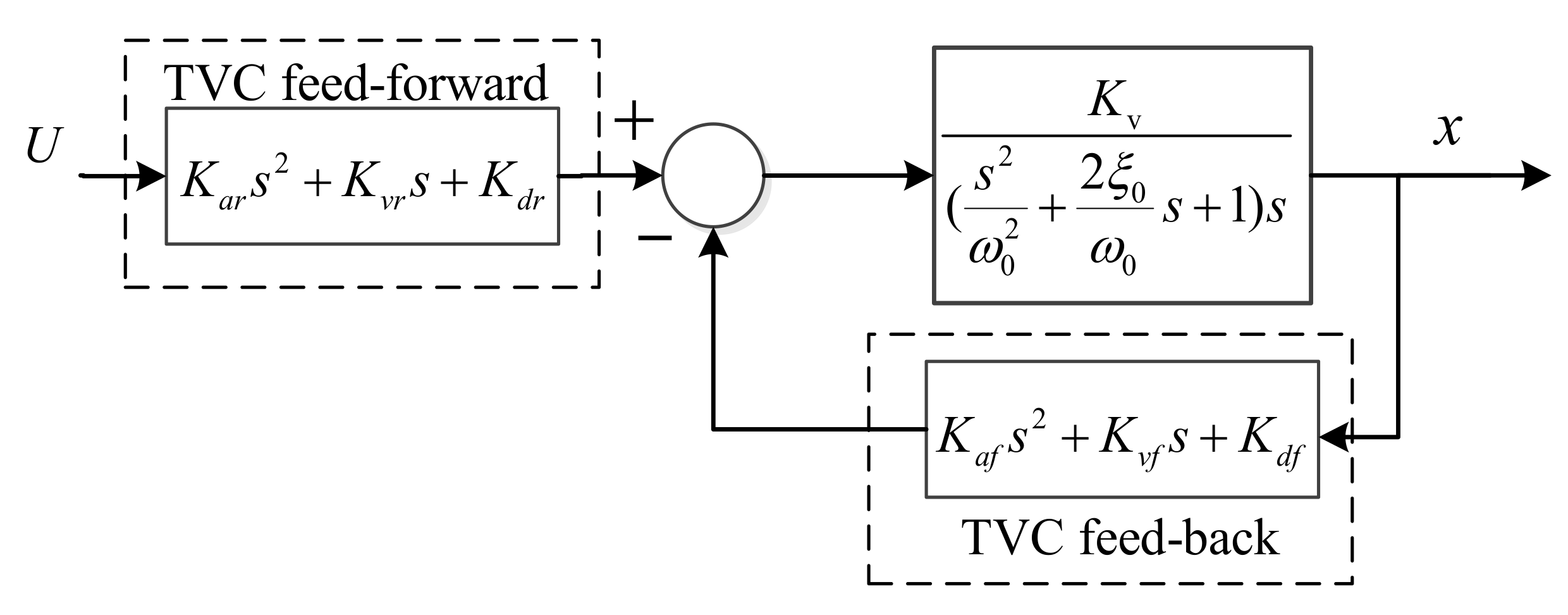
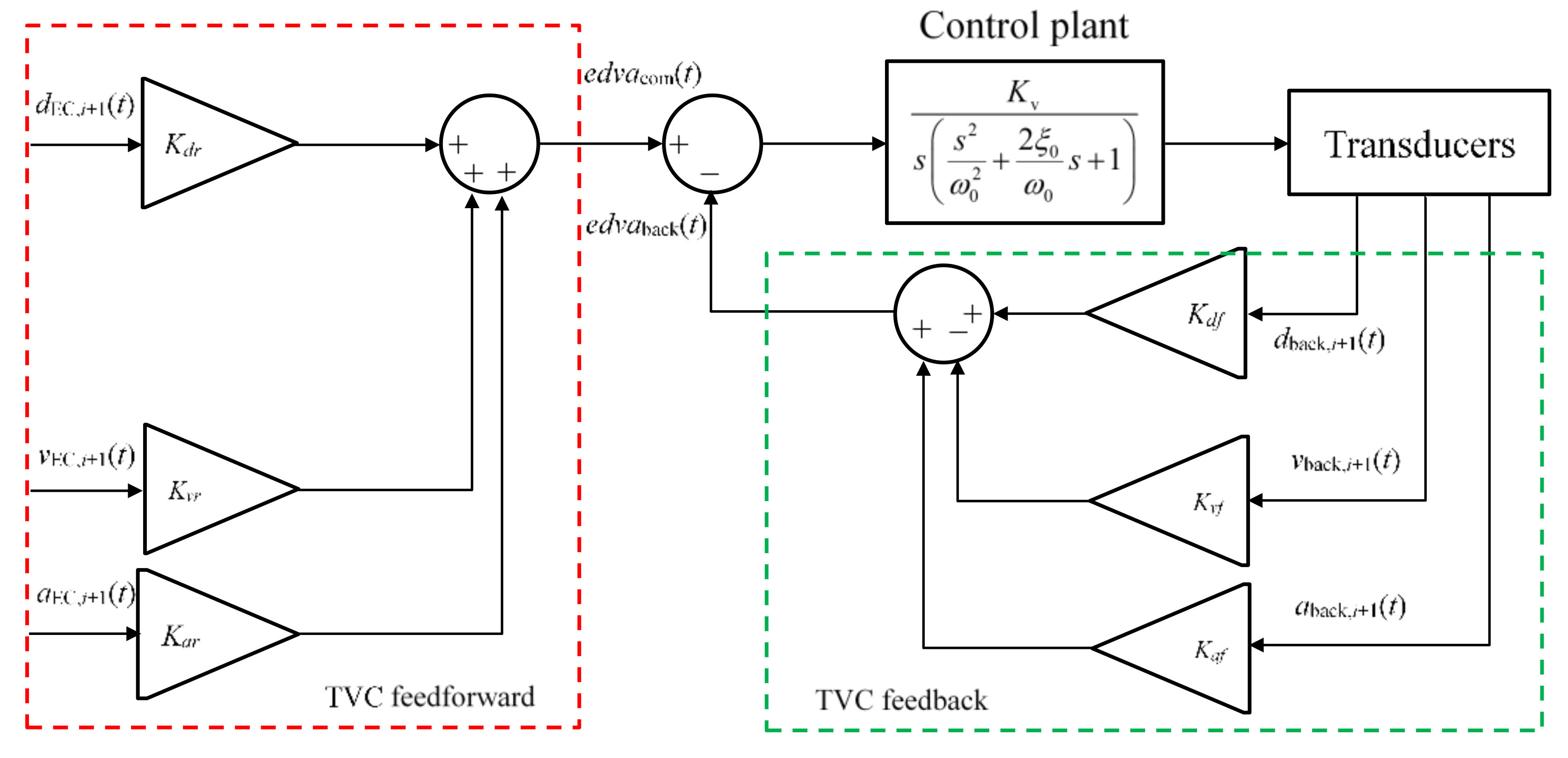
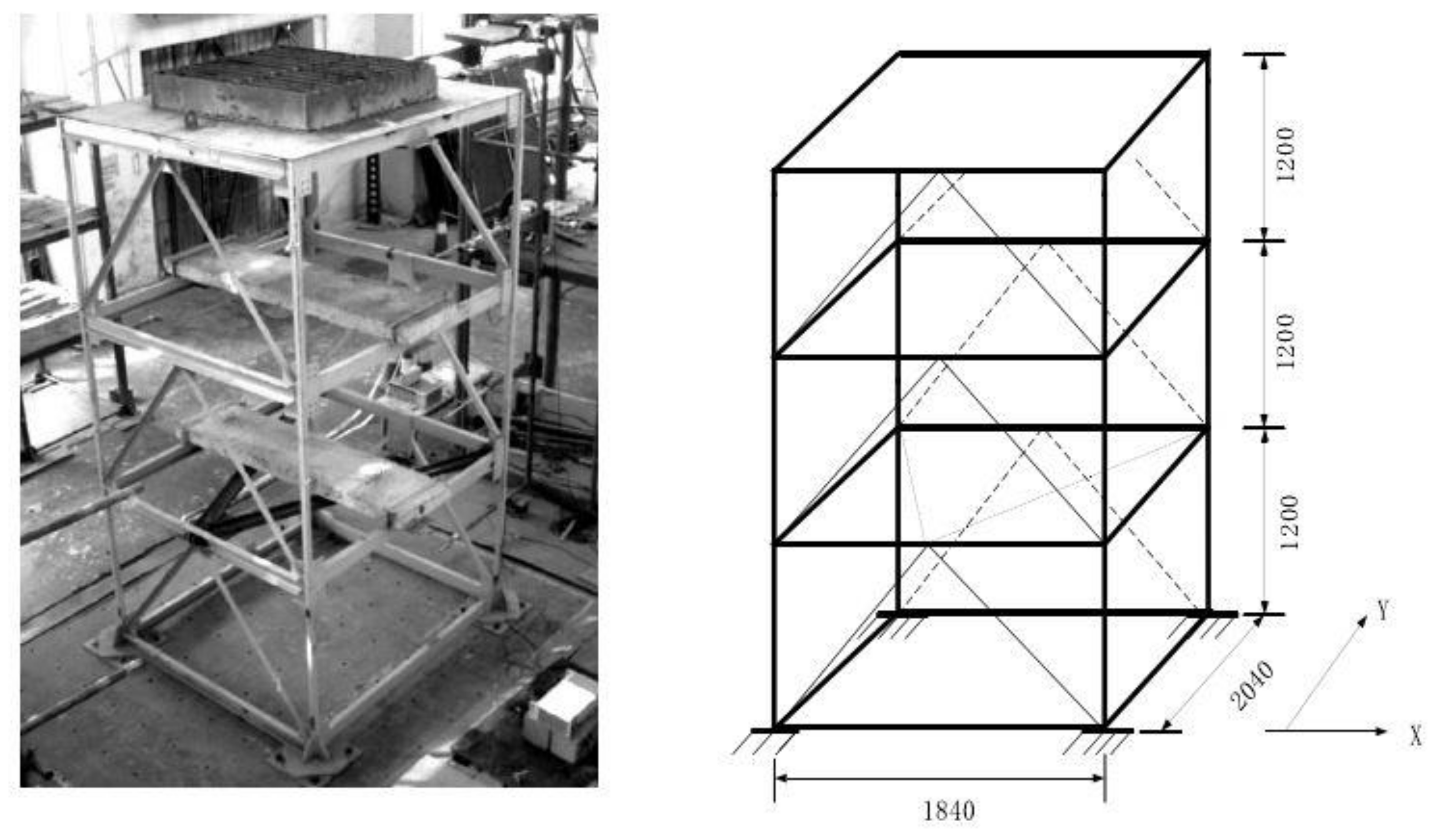
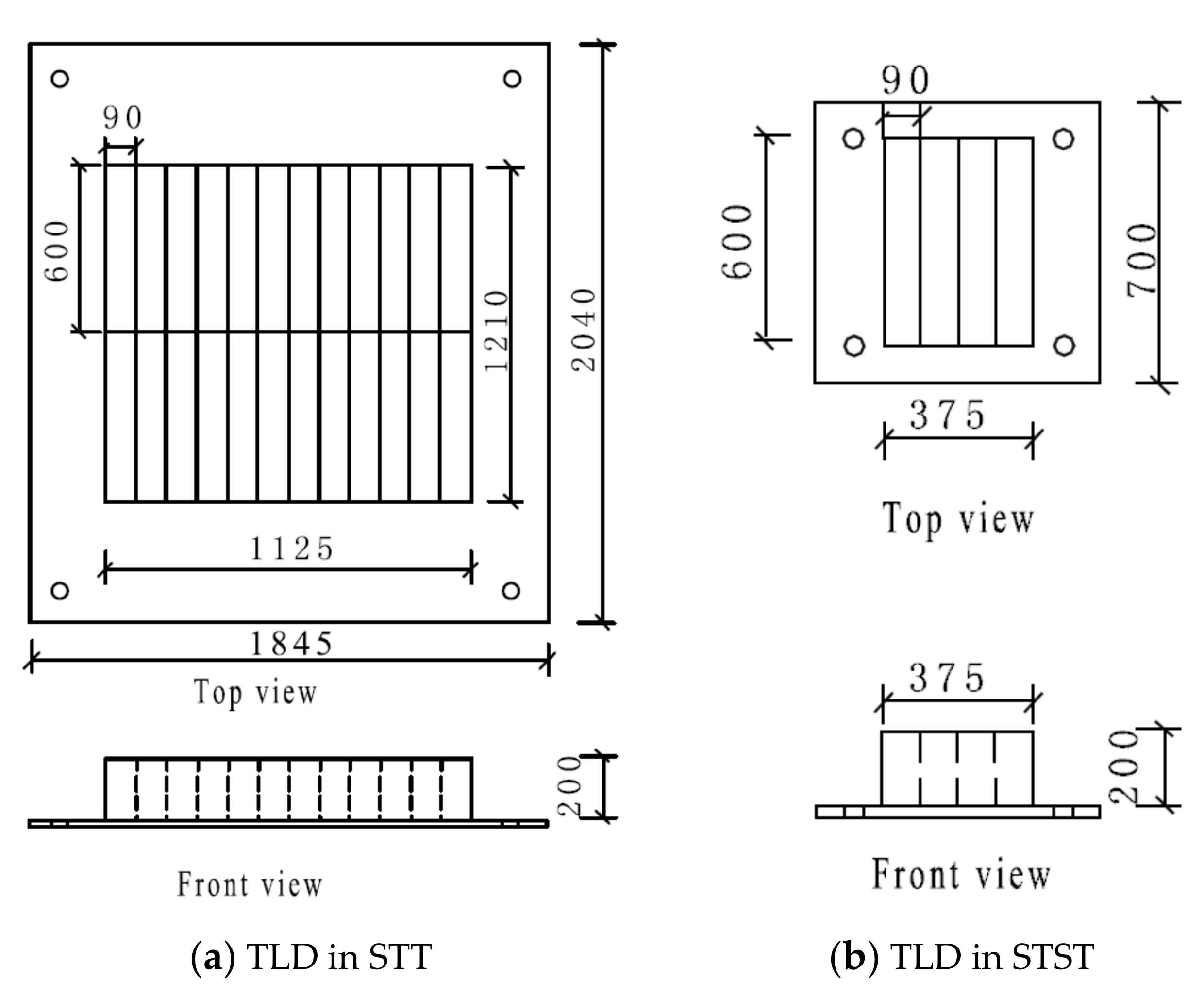

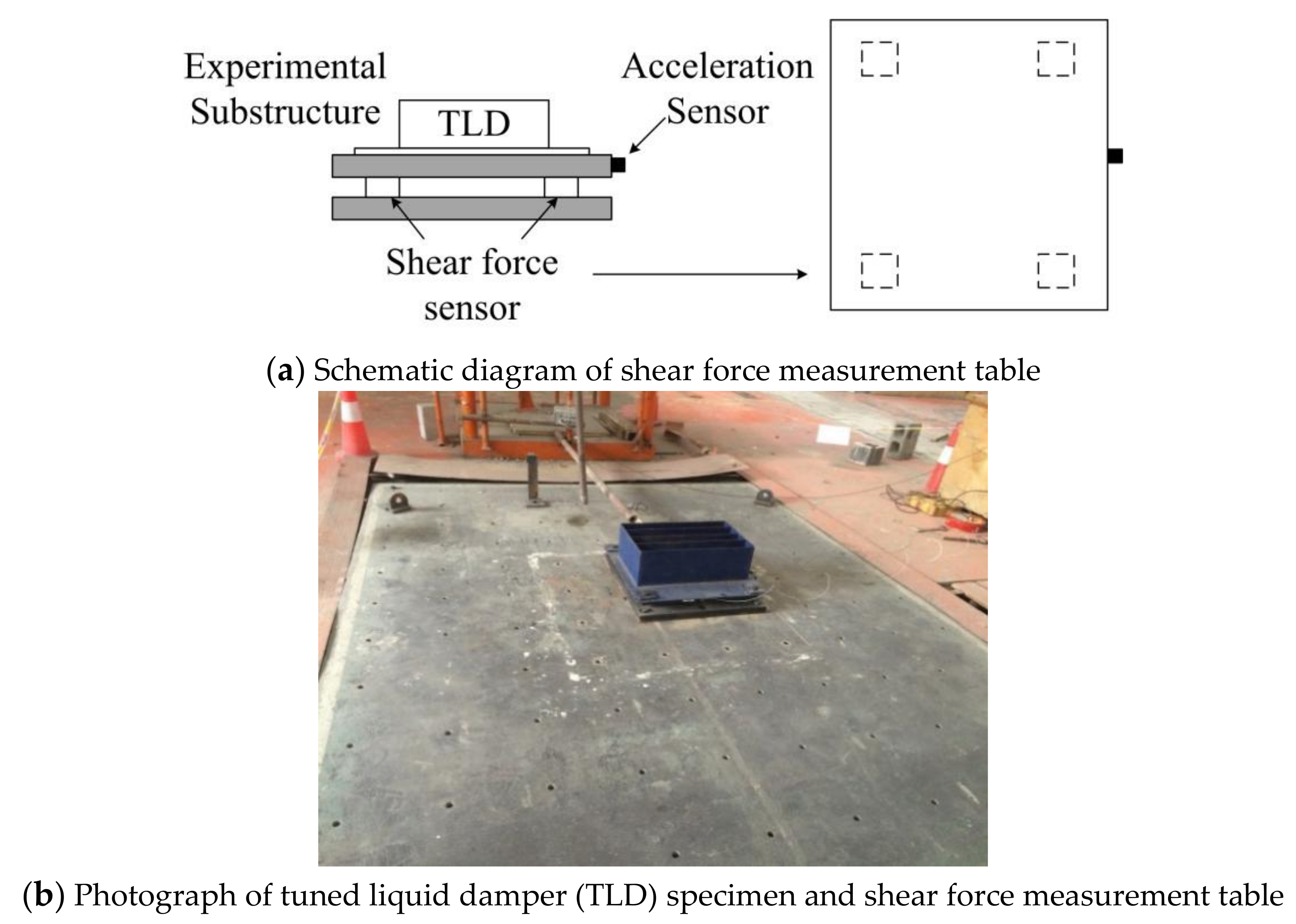
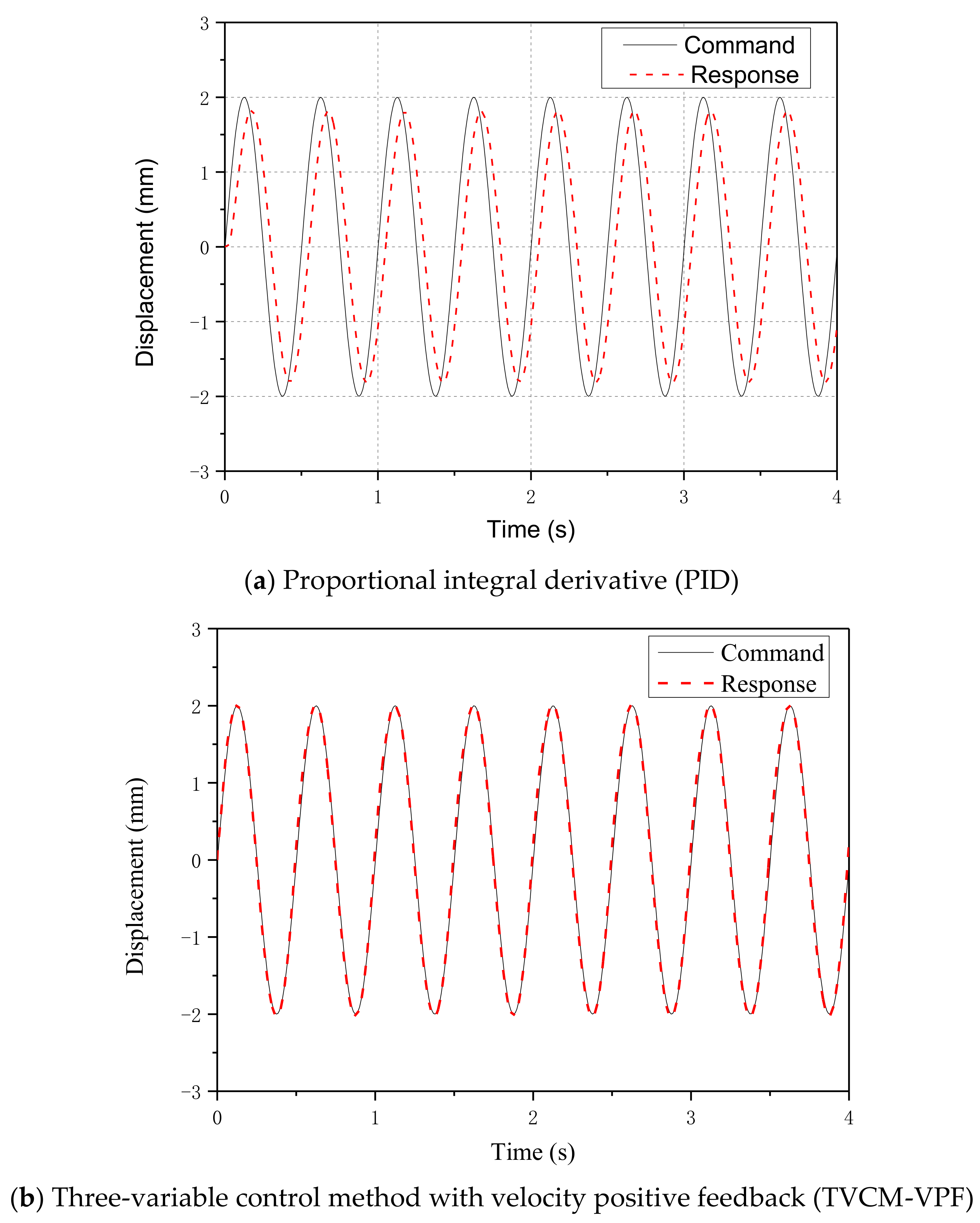
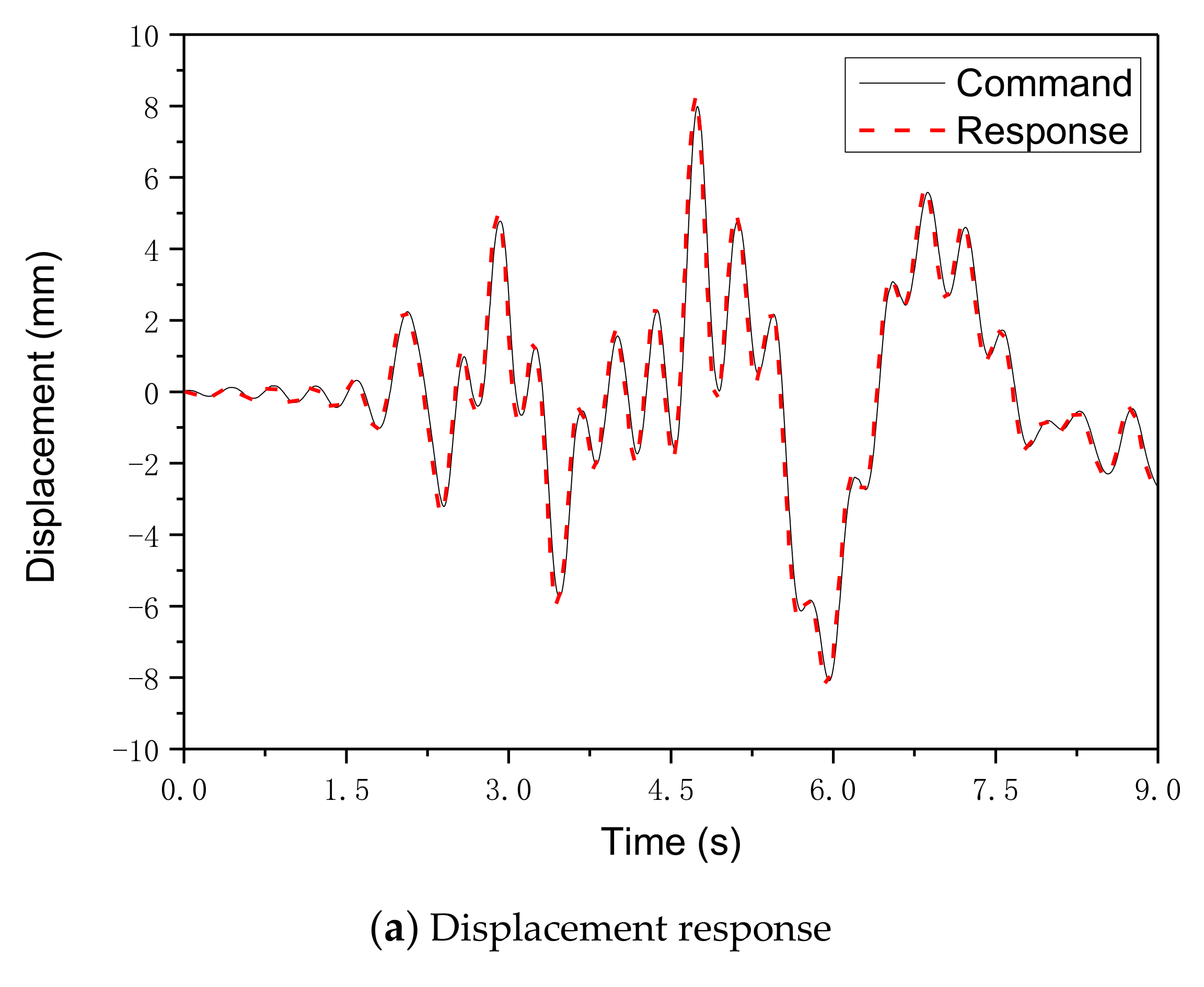
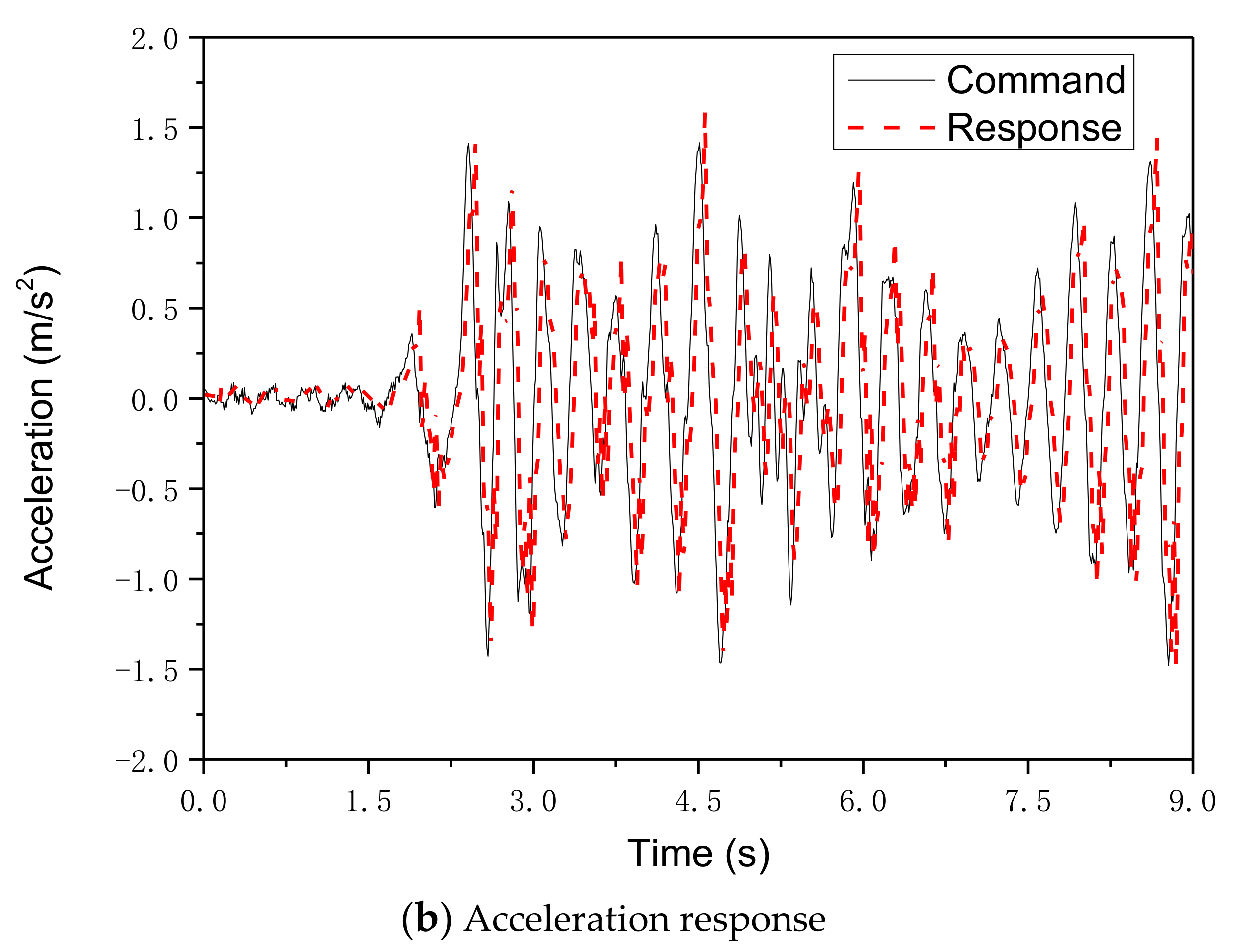
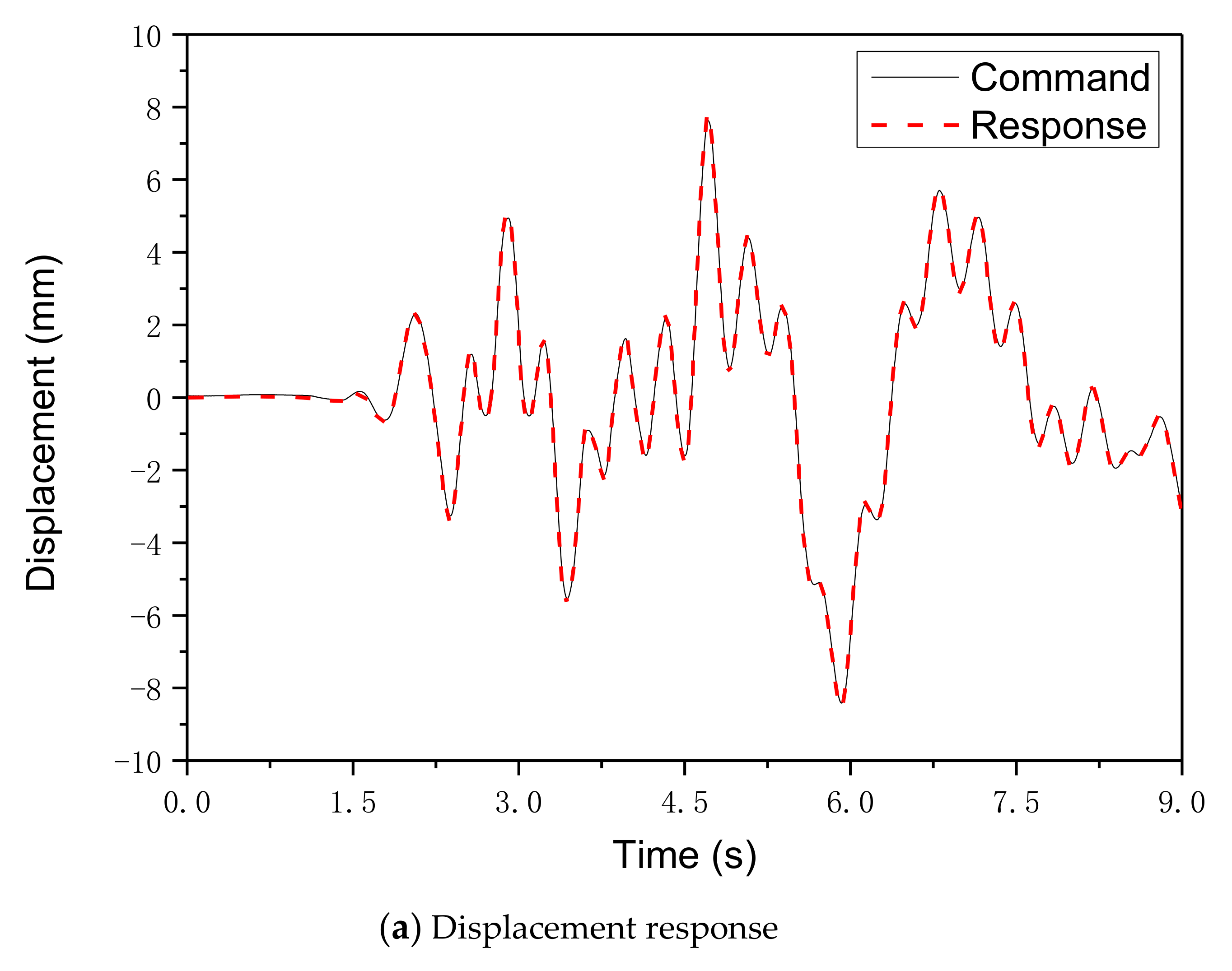
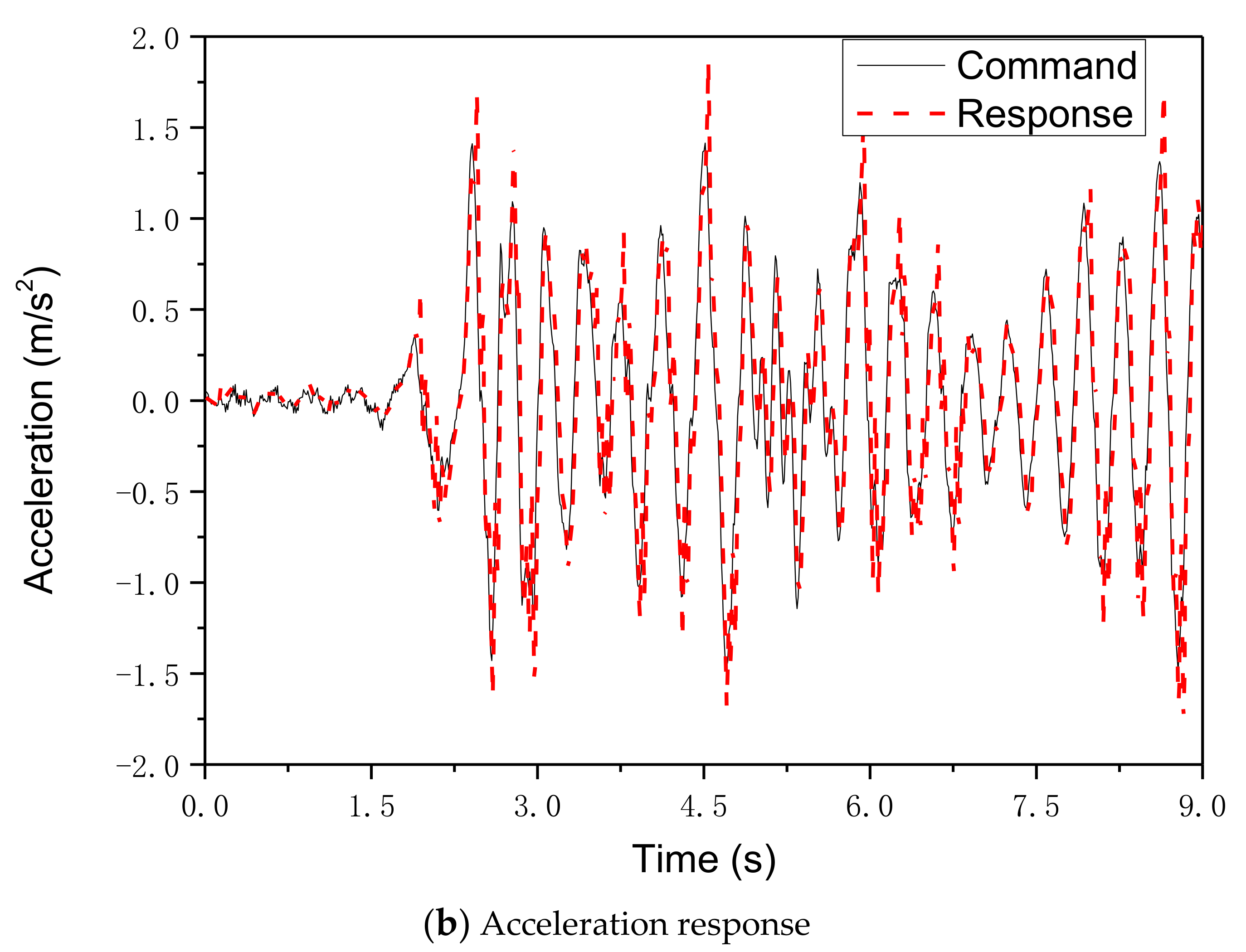
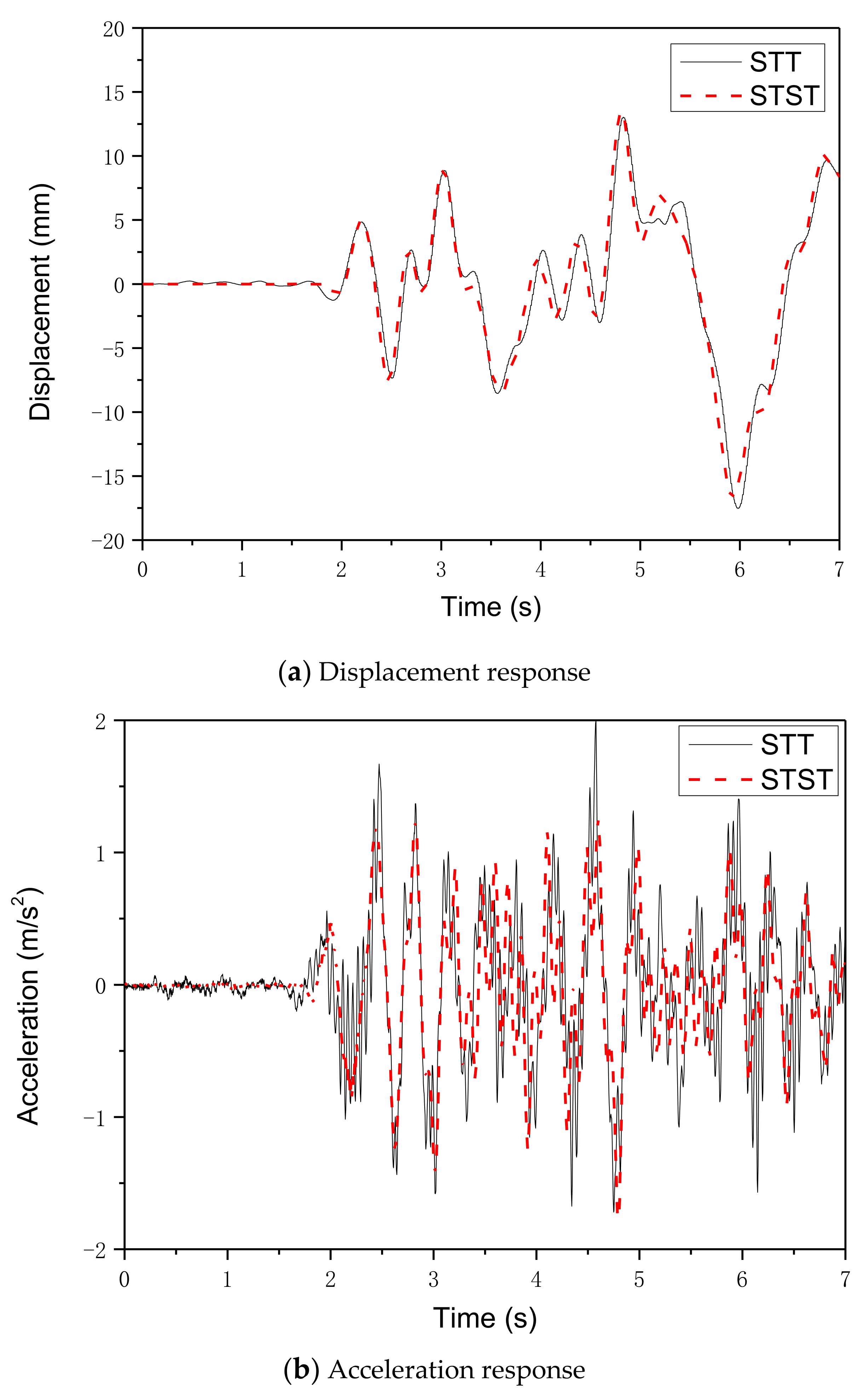
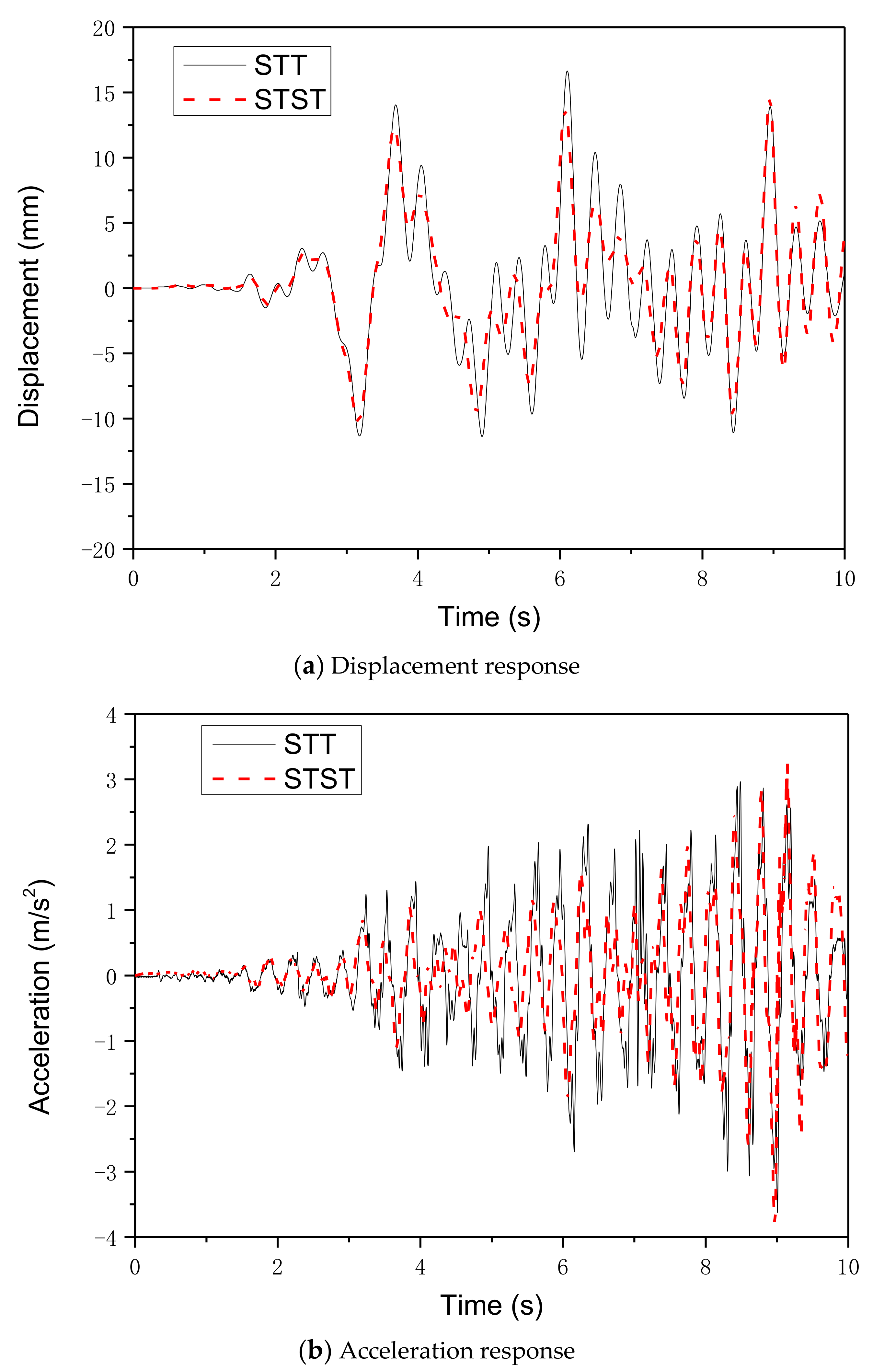
| 0.2 | −0.02 | 0.00006 | 0.2 | 0.0079 | 0 |
| Sine Wave (Hz) | Amplitude Deviation (%) | Correlation Coefficient (%) | ||
|---|---|---|---|---|
| PID | TVCM-VPF | PID | TVCM-VPF | |
| 0.5 | 0.44 | 0.37 | 99.34 | 99.98 |
| 1 | 0.73 | 0.55 | 98.95 | 99.84 |
| 2 | 11.4 | 0.53 | 83.81 | 99.36 |
| 4 | 33.7 | 0.83 | 65.32 | 99.21 |
| Controller | Response | Amplitude Deviation (%) | Correlation Coefficient (%) |
|---|---|---|---|
| PID | Displacement | 1.71 | 98.62 |
| Acceleration | 6.47 | 67.73 | |
| TVCM-VPF | Displacement | 1.52 | 99.88 |
| Acceleration | 6.61 | 90.22 |
| Earthquake | Response | Amplitude Deviation (%) | Correlation Coefficient (%) |
|---|---|---|---|
| El Centro | Displacement | 4.48 | 97.39 |
| Acceleration | 11.38 | 66.21 | |
| Taft | Displacement | 12.17 | 92.03 |
| Acceleration | 4.82 | 65.47 |
© 2020 by the authors. Licensee MDPI, Basel, Switzerland. This article is an open access article distributed under the terms and conditions of the Creative Commons Attribution (CC BY) license (http://creativecommons.org/licenses/by/4.0/).
Share and Cite
Xu, G.; Wang, Z.; Bao, Y.; Yang, G.; Wu, B. Shaking Table Substructure Testing Based on Three-Variable Control Method with Velocity Positive Feedback. Appl. Sci. 2020, 10, 5414. https://doi.org/10.3390/app10165414
Xu G, Wang Z, Bao Y, Yang G, Wu B. Shaking Table Substructure Testing Based on Three-Variable Control Method with Velocity Positive Feedback. Applied Sciences. 2020; 10(16):5414. https://doi.org/10.3390/app10165414
Chicago/Turabian StyleXu, Guoshan, Zhen Wang, Yintong Bao, Ge Yang, and Bin Wu. 2020. "Shaking Table Substructure Testing Based on Three-Variable Control Method with Velocity Positive Feedback" Applied Sciences 10, no. 16: 5414. https://doi.org/10.3390/app10165414
APA StyleXu, G., Wang, Z., Bao, Y., Yang, G., & Wu, B. (2020). Shaking Table Substructure Testing Based on Three-Variable Control Method with Velocity Positive Feedback. Applied Sciences, 10(16), 5414. https://doi.org/10.3390/app10165414






